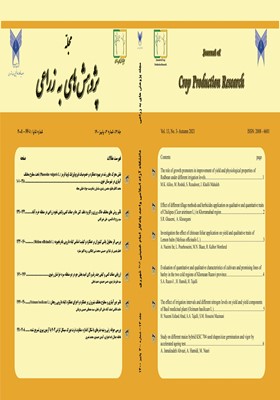The role of growth promoters in improvement of yield and physiological properties of Red bean under different irrigation levels
Subject Areas : Crop Production ResearchM.K. Aliloo 1 , محسن Roshdi 2 , S. Rezadoost 3 , J. Khalili Mahaleh 4
1 - دانشجوی دکتری اگروتکنولوژی، واحد خوی، دانشگاه آزاد اسلامی، خوی، ایران
2 - استادیار، گروه زراعت و اصلاح نباتات، واحد خوی، دانشگاه آزاد اسلامی، خوی، ایران
3 - استادیار، گروه زراعت و اصلاح نباتات، واحد خوی، دانشگاه آزاد اسلامی، خوی، ایران
4 - استادیار، گروه زراعت و اصلاح نباتات، واحد خوی، دانشگاه آزاد اسلامی، خوی، ایران
Keywords: Humic acid, harvest index, Leaf relative water content, Growth promoter, Yield protein,
Abstract :
An experiment in the form of split-plot design with randomized complete blocks was performedin three replications in Pyrmosi village of Khoi city during 1400 in order to evaluate theresponse of yield and physiological properties of red beans to the application of growthpromoters under different irrigation levels. Irrigation was considered as the main factor in threeirrigation levels, i.e., once in 8, 11 and 14 days, and the growth promoting compounds wereviewed as the secondary factors in 5 levels, i.e., the use of humic acid mixed with irrigationwater, amino acid foliar spraying, rooting stimulant, potassium and non-use of growthpromoters was (control). The results of analysis of variance indicated that irrigation had asignificant impact on all the traits studied, and the growth promoters affected the leaf relativewater content, chlorophyll a, protein percentage, number of lateral branches, seed yield, andharvest index significantly. The interaction of the two factors had significant effects on thenumber of lateral branches, seed yield, harvest index, and seed protein percentage. Theapplication of humic acid resulted in increased seed yield, and as the water deficit increased, theeffect of humic acid on increasing seed yield became significant. The highest seed yield was3076.12 kg per hectare observed in the irrigation level of once every 8 days and under thehumic acid treatment, and the lowest level of this trait was 1220.96 kg observed in the irrigationlevel of once 14 days and under the control treatment. It seems that increased irrigation intervalduring the growing season led to yield loss and degradation of physiological properties such asleaf area index, chlorophyll, and leaf relative water content, and the use of compounds such ashumic acid moderated the decreasing drought stress effects to some extent.
_||_


